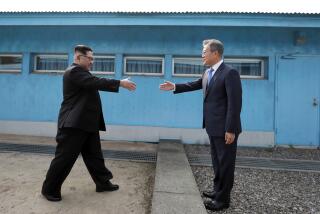Dash of Cold Water on Summit Euphoria
Two things are now clear about the Reykjavik summit. One is that it was incredibly ill-prepared on the U.S. side. The other is that, if President Reagan and Soviet leader Mikhail S. Gorbachev had reached final agreement on their much ballyhooed deal on offensive and defensive nuclear weapons, the agreement would almost surely have come unstuck anyway.
A week after the summit confusion still reigns, inside as well as outside the Administration, on just what transpired. But it seems that the leaders agreed in principle to eliminate both sides’ medium-range missiles in Europe, to cut each side’s offensive strategic nuclear forces in half within five years and to abolish all ballistic missiles within 10 years.
This is mind-boggling stuff. People the world over passionately desire an end to the nuclear arms competition. The deal fell through, however, because the Soviets made the whole package contingent upon U.S. agreement to keep its strategic missile defense program inside the laboratory. Reagan refused.
Reactions have been wildly divergent.
People as disparate as former Secretary of Defense Robert McNamara, former British Foreign Secretary David A.L. Owen and Reagan himself are talking in glowing terms of a near-breakthrough achieved at the summit--an achievement, they say, that can now be built upon in further negotiations.
Ultra-conservatives applaud the President for refusing to trade away his Strategic Defense Initiative. Liberal critics charge that Reagan blew a “grand and historic opportunity” to achieve sweeping cuts in U.S. and Soviet nuclear arsenals.
Two national security advisers to former Presidents, Henry Kissinger and Zbigniew Brzezinski, praise Reagan’s handling of the summit up to a point, but caution that the two leaders were in fact nowhere near closing a deal at Reykjavik.
Sam Nunn (D-Ga.), the most respected senator in either party on military affairs, suggests that Reagan’s precipitate offer to eliminate ballistic missiles was so potentially dangerous that it should be withdrawn before the Soviets accept it.
Follow-up talks at Geneva may soon throw some light on who is closest to the mark. As of now, the only thing that’s clear is that, at least on the American side, the Reykjavik summit was hardly an exercise in cooly calculated diplomacy.
Reagan was not much interested in East-West summitry during his first term. But his get-together with Gorbachev a year ago in Geneva whetted his appetite for more. When the Daniloff affair and continued disagreement over SDI clouded plans for a Gorbachev visit to America, the President accepted a Soviet bid for an interim meeting in Iceland.
The Reykjavik summit was described in advance as intended only to break the logjam, to produce some marching orders for the negotiators on both sides. But the two leaders quickly went beyond these parameters to come within an ace, according to their own accounts, of some fundamental agreements.
This would have been fine if the ground had been carefully prepared, but it wasn’t.
Even now the U.S. participants are unclear on whether Reagan’s offer called for the eventual abolition only of ballistic missiles, or if it also included bombers and cruise missiles. But either approach raises serious questions that had not been thought through before the summit.
Kissinger comments, “As a veteran of four summits I get a sinking feeling when I read of fundamental agreements being drafted overnight on subjects never explored in preliminary conversations. Nor do I think the United States and the Soviet Union were anywhere close to a completed agreement, much less a useful one.
“The negotiations defining what weapons were to be destroyed, the rate of destruction and verification of the process would be so complex that they could easily consume much of the 10 years and might break down at any of the many stages needed,” Kissinger added.
The dash of cold water is unfortunately supported by the facts, for reasons outlined by Nunn.
Elimination of all ballistic missiles would leave the United States more vulnerable to a bomber attack than the Soviet Union because, while we have more bombers, they have a formidable air defense and we have almost none.
Abolition of all medium-range missiles in Europe--coupled with the later elimination of all ballistic missiles of whatever range--would leave the Western powers outgunned by Warsaw Pact forces that are far superior in conventional, non-nuclear firepower. The imbalance could be corrected by a big buildup in conventional weapons on the Western side, but there is no reason to believe that the Europeans are willing to pay for such a program--and a lot of reason to believe that they are not.
Such obstacles might not be insuperable, given careful and inevitably protracted negotiation. But it’s disturbing that Reagan made his zero-missile proposal without consulting his Joint Chiefs of Staff. Nor did he consult the military leaders of the allied countries in Europe--a fact that has them hopping mad, since European security was on the table.
There is a decent chance that the meeting really will prove to have been a historic breakthrough. While Reagan and Gorbachev were in the end unable to make a deal, their sweeping offers remain on the table in Geneva, where they may yet form the building blocks of arms reduction agreements going far beyond anything done before. If that happens, the two leaders will deserve great credit for breaking through the obstacles of national pride and bureaucratic inertia.
But no one should lose sight of the fact that there is, and inescapably was at Reykjavik, a very wide gap between the wish and the reality.
More to Read
Sign up for Essential California
The most important California stories and recommendations in your inbox every morning.
You may occasionally receive promotional content from the Los Angeles Times.










